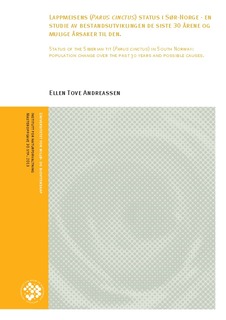Lappmeisens (Parus cinctus) status i Sør-Norge - en studie av bestandsutviklingen de siste 30 årene og mulige årsaker til den
Master thesis

View/
Date
2013-04-18Metadata
Show full item recordCollections
- Master's theses (INA) [593]
Abstract
The Siberian tit is a northern taiga species and a habitat specialist. There is a small population in South Norway, with a limited range in northern parts of Hedmark county and adjoining areas in
Oppland and Sør‐Trøndelag counties. The Finnish population declined considerably in the latter
half of the 1900s as a result of clear‐cutting of forest. Little new information about the South
Norwegian population has been obtained since Bengtson & Sonerud (1991) published their
review of population status and trends up to the 1980s. In the present study, a line‐transect
census was carried out along a total length of 314 km of suitable biotope. The aim was to obtain
up‐to‐date information on population status and, in the event that there had been a decline,
whether this could be due to forestry or to more intense interspecific competition as a result of
climate change and/or winter feeding by humans. Only five Siberian tit territories were found,
while 191, 38 and 109 territories respectively were recorded for willow tit, crested tit and great
tit. The census also indicated that the range of the Siberian tit has shrunk over the past 30 years,
becoming restricted to three core areas: around the northern half of Lake Femunden, Aumdalen
and Folldal. Some areas that were censused in the late 1970s, were recensused during the
present study, and no Siberian tits were found in areas where the species previously made up
9 % of the avian community. The proportion of willow and great tits was considerably higher
than in the late 1970s. Analyses showed little difference between the tit species in habitat
choice. Nor was there any tendency for Siberian tits to be observed at higher elevations than
previously, which would be a probable response to climate change. Bengtson & Sonerud (1991)
estimated that the Siberian tit population in South Norway was at least 1000 pairs in the late
1970s. On the basis of the new census, it is estimated that the population is now roughly 70–140
pairs, which corresponds to a population decline of 86–93 %. This may be linked to the general
decline that has been observed in the Swedish population during roughly the same period.
Possible reasons suggested for the population decline are a combination of felling of old‐growth
forest and more intense competition with other species of tits, which could in turn be a result of milder winters and more winter feeding. The thesis discusses possible management measures in
response to the decline. Lappmeis er en nordlig taigaart og en habitatspesialist. Den sørnorske populasjonen er liten, og
utbredelsen begrenser seg til de nordlige delene av Hedmark med tilgrensende områder i
Oppland og Sør‐Trøndelag. Den finske bestanden har gått kraftig tilbake på siste halvdel av
1900–tallet på grunn av hogst. Det er lite ny kunnskap om den sør‐norske bestanden siden
Bengtson & Sonerud (1991) sin oppsummering av status fram til 1980‐tallet. For å få ny
kunnskap om bestandsutviklingen, og om årsaken til en eventuell nedgang i bestanden kan
skyldes hogst eller økt interspesifikk konkurranse grunnet klimaendringer og/eller
vinterfôringer, takserte vi 314 kilometer i egnet biotop. Vi fant 5 territorier av lappmeis, mens
for granmeis, toppmeis og kjøttmeis fant vi henholdsvis 191, 38 og 109 territorier. Lappmeisens
utbredelse hadde også i løpet av de siste 30 årene krympet mot tre gjenværende kjerneområder
i Femundstraktene, Aumdalen og Folldal. Også retakseringer av områder som ble undersøkt på
slutten av 1970–tallet, viste at lappmeis ikke ble observert i områder hvor den utgjorde 9 % av
fuglesamfunnet tidligere. I den samme perioden hadde andel av granmeis og kjøttmeis økt nokså
betydelig. Analyser viste også at det var liten forskjell i habitatvalg mellom meiseartene. Med
hensyn til eventuelle klimaendringer viste analysene også at det var ingen trend på at
lappmeisfunn lå høyere over havet nå enn før. På slutten av 1970–tallet var bestandsestimatet
fra Bengtson & Sonerud (1991) minst 1000 par. I dag anslår vi en bestandsstørrelse på omtrent
70–140 par. Lappmeisens nedgang i bestanden vil etter dette være på 86–93 %. Nedgangen kan
relateres til en generell bestandsnedgang i Sverige i omtrent samme periode. Vi antar at
bestandsnedgangen kan skyldes en kombinasjon av avvirkning av eldre skog og økt konkurranse
fra andre meiser, som igjen kan skyldes både mildere vintre og økt fôring om vinteren. Mulige forvaltningstiltak blir diskutert.